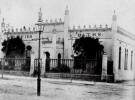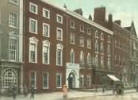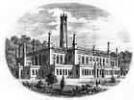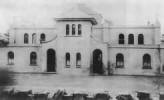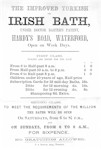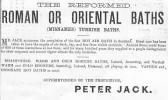3.
Naming the bath

While supporting the use of the bath as a therapeutic agent, Urquhart, as a non-physician, saw it more as a cleansing agent for those without water at home.
His other agenda, however, was popularising Turkish culture, so for him, the bath could only be called a Turkish bath, although, like York James Moore, there were a few others who—with little justification—called it the Anglo-Turkish Bath.5

Barter saw the bath primarily as a therapeutic agent, and since hydropathy was often seen as a quack medicine, he may have felt the need of as much respectability as possible, and he called his bath the ‘Improved Turkish or Roman Bath’.

 The improved bath was undoubtedly an improved therapeutic agent, but his use of the words ‘improved Turkish’ was criticised by some as arrogance. However, the word may have been suggested by the required title of his patent application—Improvements in heating and ventilating buildings—which,
like all patents—had to be for an invention which was either new, or
improved.6
The improved bath was undoubtedly an improved therapeutic agent, but his use of the words ‘improved Turkish’ was criticised by some as arrogance. However, the word may have been suggested by the required title of his patent application—Improvements in heating and ventilating buildings—which,
like all patents—had to be for an invention which was either new, or
improved.6
Apart from a succession of Turkish baths at St Ann’s, Barter built, or was involved in setting up, ten others in Ireland, and one in London.
Military Road baths, Limerick
Upper Sackville Street, Dublin
Quinsborough Road, Bray
All those in Ireland included Turkish in their names, some preceded by ‘improved’, others with ‘or Roman’ added.
Hardy's Road, Waterford
Two stand out as being different. That in Bray was called ‘the Improved Turkish or New Irish Bath’, and the one in Waterford was called ‘the Improved Turkish or Irish Bath’ and, for the first and only time, the typographical emphasis was on ‘Irish’.
Other Irish proprietors might have adopted the term Irish bath, but in January 1860 Barter’s baths were subjected to an ill-informed attack by the writer Richard Robert Madden, published in the Dublin Hospital Gazette and reprinted in the Cork Daily Herald.7
Richard Robert Madden
Madden maintained, first, that the dry air of the Irish bath was medically harmful by comparison with the vaporous air of the true Turkish bath; second that the flue system in Barter’s baths were faulty and dangerous.
Having been refused space in the Gazette, Barter replied only in the Herald. Letters were published also from Barter’s supporters, and the attack was soon rebuffed with, according to one pamphlet edited by 'Photophilus', ‘a display of inherent vitality'.8
Nevertheless, such arguments about whether 'dry' air was preferable to ‘humid’ air were to be repeated from time to time, and this may have discouraged proprietors from adopting the term ‘Irish Bath’.
On the mainland, most establishments followed Urquhart’s example. After all, newspaper and magazine articles invariably referred to Turkish baths, and it would have been foolhardy not to take commercial advantage of this.
There were exceptions, of course. In academic Cambridge, the Roman Bath Company Limited advertised their new establishment as ‘a Public and Private Thermae and Swimming Bath’. Their name, the Roman Bath Company, was specifically chosen to bring Roman culture to mind, to indicate that their hot rooms were dry, and that there was a plunge pool. (It is to be doubted, however, whether they replaced the Turkish shampoo with oil and strigil.)
But even in Cambridge, advertising thermae did not make commercial sense and, for this, and a variety of other reasons, the baths barely lasted a year. Sir Matthew Digby Wyatt’s elegant building still stands, although the plunge pool soon disappeared, and the room is now a pizza restaurant.
Another exception was an establishment in Glasgow where, if no-one actually called their baths Scottish Baths, the independent-minded Peter Jack made sure that everyone knew his baths were nothing to do with Turkey.
There was much discussion in print. Many ‘Letters to the Editor’, even to such journals as The Lancet or The British Medical Journal, expressed views which were, to put it mildly, xenophobic. Dr Thomas Garlike, for example, asked:
Can the active, fox-hunting, cricketing, boating English-man bear the same kind of treatment that benefits and gratifies the indolent, languid, luxurious Turk?9
Their writers tended to be doctors who were against the bath. But some protagonists, and some of those warning against its ‘overuse’, like Dr Henry W Kiallmark, often accepted the same underlying assumptions.
It must never interfere with, or take the place of, the Englishman’s daily ‘tub’; and, with this proviso, the alarm expressed by some, that it will lead to effeminacy and degeneracy of race, as it is said to have done with the ancient Romans and the modern Turks, may be looked upon as fallacious.10
What seems surprising is that even in Ireland, appending a Turkish or Roman culture to the bath instead of an Irish culture, was still considered preferable, despite contemporary perceptions of the Romans as being debauched, and the Turks as indolent and effeminate.

